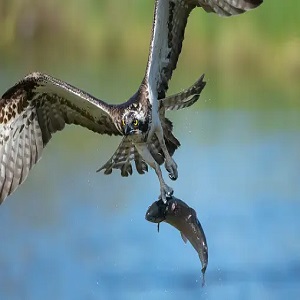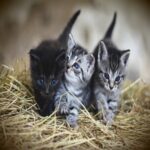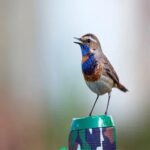Introduction Of Florida Beach Birds
Florida beach birds’ coastal havens host a rich array of beach birds, including the iconic Brown Pelican, agile Sanderling, and laughing gulls with their distinctive calls. The elegant Snowy Egret flaunts vibrant yellow feet, while the Roseate Spoonbill stuns with its pink plumage. Watch the majestic Osprey dive for fish, and spot the Black Skimmer’s unique bill slicing through the water. From the dainty Least Tern to the patient Great Blue Heron, these birds embody the Sunshine State’s shoreline charm. Don’t miss the striking American Oystercatcher and the playful Reddish Egret, adding to the vibrant tapestry of Florida’s coastal avifauna.
20 Types Of Florida Beach Birds
1. American Oystercatcher
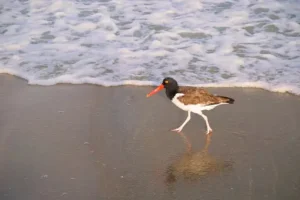
- The American Oystercatcher, a charismatic coastal dweller in Florida, boasts bold black and white plumage. Its vibrant orange bill and eyes add a striking contrast.
- This shorebird relies on its sturdy bill to pry open shellfish, making it a skilled mollusk hunter. With its distinct calls and striking appearance, the American Oystercatcher is a captivating emblem of Florida’s beachside biodiversity.
- From the dainty Least Tern to the patient Great Blue Heron, these birds embody the Sunshine State’s shoreline charm. Don’t miss the striking American Oystercatcher and the playful Reddish Egret, adding to the vibrant tapestry of Florida’s coastal avifauna.
2. Black-bellied Plover
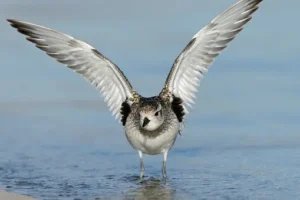
- The black-bellied plover has a unique fashion sense. During the breeding season, its underbelly turns black, contrasting starkly with its pale upperparts. This color change is a prime example of bird molting and is used to attract potential mates.
- Known for their extraordinary migrations, the black-bellied plover undertakes one of the longest journeys of any shorebird. For the winter, it migrates from arctic breeding grounds to warmer coastal areas, including Florida. This voyage showcases the bird’s endurance and navigational skills.
- To satisfy its appetite for marine invertebrates, the black-bellied plover employs a fascinating foraging technique. It scans the sand for worms and small critters with its short beak, often running along the shore to locate its prey. This behavior underscores its adaptation to the coastal environment and demonstrates its resourcefulness in foraging.
3. Black Skimmer
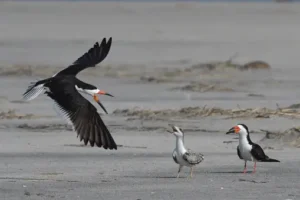
- The Black Skimmer is instantly recognizable by its remarkable bill. The lower mandible is longer than the upper, allowing the bird to glide low over water and skim the surface with its lower jaw. This unique adaptation helps it catch fish by touch, making it an extraordinary aerial fisherman.
- This bird is most active during the early morning and late evening, earning it the nickname “sea bat. Its crepuscular behavior allows it to take advantage of low light conditions for hunting, as well as to avoid the heat of the day.
- Black Skimmers often nest in colonies, creating communal breeding sites on sandy or gravelly beaches. They form shallow scrapes in the sand where eggs are laid, and their ground-level nesting makes them vulnerable to human disturbance and habitat loss.
- The Black Skimmer is listed as a species of concern in many areas due to habitat degradation and disturbance. Coastal development, disturbance from recreational activities, and loss of nesting sites are significant threats to their populations. Conservation efforts aim to protect their breeding sites and educate the public about their importance in coastal ecosystems.
4. Brown Pelican
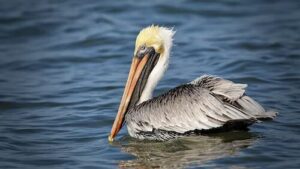
- The brown pelican is famous for its spectacular deep diving technique. Soaring above the water, it unfolds its wings and plunges headlong into the sea to catch fish. The elastic throat pouch expands to accommodate water and fish – a remarkable display of precision and dexterity.
- Unlike most birds, the brown pelican’s pouch is not designed for conservation. Instead, it serves as a net to catch fish while diving. After collecting the prey, the pelican drives out the water and swallows the fish whole.
- Brown pelicans experienced a severe population decline in the mid-20th century due to the effects of the pesticide DDT. Post-ban conservation efforts have resulted in a remarkable recovery. The resurgence of the species testifies to the importance of environmental management.
- Often gliding gracefully along coasts, these pelicans serve as guardians of the marine environment. Their presence is a symbol of healthy coastal ecosystems, as their survival depends on clear water and plentiful fish stocks.
Must See This: 8 Outstanding Points About The Diet Of Baby Pigeons
5. Common Loon
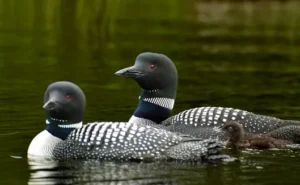
- The Common Loon is famous for its haunting, eerie calls that echo across northern lakes. These vocalizations are distinct and play a significant role in territorial communication and mate selection.
- A skilled aquatic predator, the Common Loon is an exceptional diver. Its legs are positioned far back on its body, making it well-suited for underwater propulsion. It can dive as deep as 200 feet (60 meters) to chase and capture fish.
- Common Loons are migratory birds, breeding in freshwater lakes and ponds in the northern parts of North America and then flying south to coastal areas and larger bodies of water for the winter. They are known for their striking black-and-white breeding plumage.
- While not endangered, the Common Loon faces threats from habitat loss and disturbance due to human activity on their breeding lakes. The use of lead fishing tackle also poses a significant risk, as loons can ingest lead sinkers or jigs, resulting in lead poisoning. Conservation efforts focus on protecting their nesting sites and advocating for lead-free fishing equipment.
6. Double-crested Cormorant
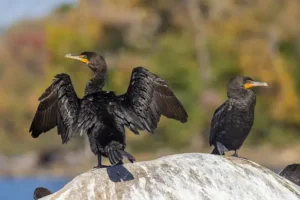
- The Double-crested Cormorant is a skilled underwater hunter. It uses its strong feet and webbed toes to propel itself through the water while chasing fish. After a dive, it often perches with its wings spread wide, a behavior that helps them dry out and regulate body temperature.
- Despite lacking a true “double crest,” these cormorants display a subtle feather tuft during the breeding season. Their long, hooked bills and dark plumage, often with a greenish sheen, contribute to their distinct appearance.
- Double-crested Cormorants are versatile birds, found in a range of aquatic habitats. They can be seen in coastal areas, lakes, rivers, and even on artificial water bodies. Their adaptability has allowed them to thrive in both freshwater and saltwater environments.
- These cormorants have faced debates due to their interactions with fisheries. While they consume fish, their impact on commercial fish populations is still a subject of study and contention. Conservationists aim to find a balance that ensures healthy fish populations while also protecting cormorant populations.
- Double-crested Cormorants often nest in colonies, sometimes alongside other water birds. They construct stick nests in trees near water, and these nesting sites can sometimes become quite crowded, with nests built close to one another.
7. Great Blue Heron
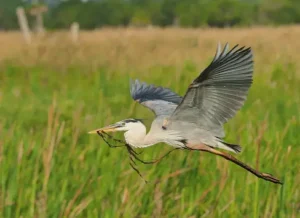
- The gray heron is a large, elegant shorebird, reaching a height of 4.5 feet (1.4 meters) and a wingspan of about 6 feet (1.8 meters). Its graceful appearance and slow, thoughtful movements make it a fascinating sight along waterways.
- Known for their patience, the Great Blue Heron is a dexterous predator that tracks its prey in shallow water. With its sharp beak, it pierces fish and other aquatic creatures with lightning.
- This heron is a versatile species found in a wide variety of aquatic habitats including coasts, swamps, rivers and lakes. Its adaptability to a variety of environments contributes to its wide distribution across North and Central America.
- Despite its name, the Gray Heron’s plumage is not always blue. During the breeding season, it develops rich blue-grey plumage on its head, neck, and back. Outside the breeding season, its plumage can appear more subtle.
- Gray herons often nest in colonies called “herons,” usually in trees near water. They build large stick nests in which to raise their young. These shared nest sites play an important role in the conservation of the species.
- After their feathers were shed and affected by habitat loss, gray heron populations recovered thanks to conservation efforts and legal protections. Today they symbolize the importance of protecting wetlands.
8. Laughing Gull
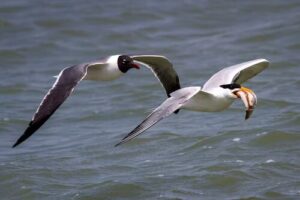
- The Laughing Gull’s striking black head during breeding season sets it apart. Its gray body, white underparts, and distinctive red bill add to its eye-catching appearance. Younger gulls have mottled brown plumage.
- Named for its distinctive “laughing” call, the Laughing Gull’s vocalizations range from harsh calls to more melodious sounds. These calls serve in communication, often intensifying during courtship and nesting.
- Highly adaptable, Laughing Gulls are commonly found along coastal areas, including beaches, piers, and harbors. They exploit various food sources, scavenging scraps and foraging for small fish, insects, and even human food.
- Laughing Gulls breed in colonies on sandy beaches and islands. They build shallow depressions in the sand for their nests and often share nesting sites with other seabirds, including terns and skimmers.
- These gulls exhibit migratory behavior, spending winters in warmer regions along the southeastern and Gulf coasts of the United States, including Florida, before returning to northern breeding grounds.
- While not globally threatened, the Laughing Gull has faced habitat disturbance and predation issues in some areas. Its adaptability and ability to coexist with human activity, however, have contributed to its relatively stable population.
Also See This: What Does It Mean When You See A Cardinal? 5 Important Points
9. Least Sandpiper
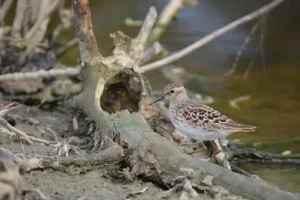
- The Least Sandpiper is one of the smallest shorebirds, measuring only about 5-6 inches (13-15 cm) in length. It undertakes impressive migrations, traveling long distances between its breeding grounds in the Arctic tundra and its wintering areas in coastal regions, including Florida.
- This sandpiper has a distinctive hunched posture, often seen with its rear end raised. It actively forages by probing its bill into mud or sand to capture tiny invertebrates and insects.
- The Least Sandpiper has a mottled brown plumage that provides excellent camouflage against its sandy or muddy habitats. This cryptic coloring helps it blend into its surroundings and evade predators.
- During migration, Least Sandpipers often form mixed flocks with other small shorebirds. These flocks provide safety in numbers and allow for more efficient foraging and predator detection.
- While they can be found in a variety of wetland habitats, such as mudflats, estuaries, and marshes, Least Sandpipers are commonly seen along Florida’s coastlines, especially during migration.
- Although Least Sandpipers are not currently listed as threatened, they face threats from habitat loss and disturbance. Conservation efforts focus on preserving their critical breeding and stopover habitats along their migratory routes.
10. Magnificent Frigatebird
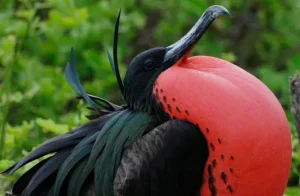
- The Magnificent Frigatebird is known for its striking appearance. It has a long wingspan of around 7.5 feet (2.3 meters) and a forked tail. The males are glossy black all over with a distinctive red throat pouch that inflates during courtship displays to attract females. Females are slightly larger than males and have a white breast and belly.
- Frigate birds are highly adapted for an aerial lifestyle. They have long, pointed wings that enable them to glide effortlessly for hours without flapping much. They are skilled at snatching prey from the ocean’s surface, including fish, squid, and other small marine animals. They are also known for their kleptoparasite behavior, where they harass other seabirds in flight, forcing them to drop their catch, which the frigate bird then steals and consumes.
- The Magnificent Frigatebird nests in colonies on remote islands and coastal areas. They build nests on shrubs, trees, or rocky outcrops. The mating and courtship rituals of these birds are impressive, with males inflating their red throat pouches to create a balloon-like display. Females are attracted to males with the largest and most inflated pouches. After mating, females lay a single egg, and both parents take turns incubating the egg and feeding the chick once it hatches.
- The Magnificent Frigatebird is not considered globally threatened and has a stable population. However, some local populations may face threats due to habitat loss, disturbance at nesting sites, and pollution. Conservation efforts often focus on protecting their breeding colonies and the surrounding marine environments.
11. Osprey Florida Beach Birds
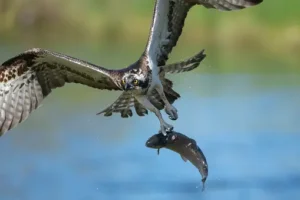
- The osprey (Pandion Haliaeetus) is a large bird of prey found around the world, known for its distinctive appearance and behavior. It has a white head, dark brown body, and a wingspan of around 5-6 feet. Ospreys are well adapted for hunting fish, which make up the majority of their diet. They are known for their impressive hunting technique, which involves hovering over water and then diving feet-first to catch fish with their sharp talons.
- The Osprey, officially designated as the MV-22 Osprey, is a tiltrotor military aircraft developed by Boeing and Bell. It’s used by the United States Marine Corps and Air Force, as well as a few other countries, for various military operations.
- The unique feature of the Osprey is its ability to take off, land, and hover like a helicopter while also flying at the higher speeds and longer ranges of a turboprop aircraft. This makes it versatile for a range of missions including troop transport, medical evacuation, and supply delivery.
12. Piping Plover Of Florida Beach Birds
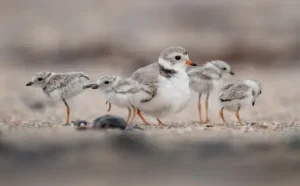
- Piping plovers are small birds with pale sandy-brown plumage on their backs and white undersides. They have a single black band across their neck and a black stripe on their forehead, along with orange legs and a short, stubby bill.
- Piping plovers are typically found in sandy coastal habitats, such as beaches, sandbars, and dunes. They nest on open sandy areas and use their well-camouflaged plumage to blend in with their surroundings.
- Piping plovers feed primarily on insects, crustaceans, and small marine invertebrates. They forage by running along the shoreline, pausing to peck at prey in the sand and shallow water.
- The piping plover is considered a species of concern in many areas of its range due to threats such as habitat destruction, disturbance by humans and pets, predation, and climate change. Efforts are underway to protect and conserve piping plover populations, including through habitat management, nest protection, and public education.
May You Love That: 4 Outstanding Facts Of The Western Meadowlark
13. Red Knot Of Florida Beach Birds
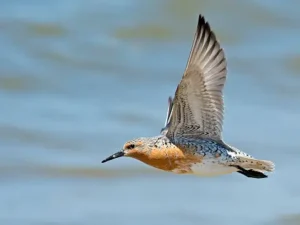
- The red knot is a medium-sized bird with a plump body, short legs, and a slightly curved bill. In its breeding plumage, it has a reddish-brown face and breast, which gives it its name. During the non-breeding season, its plumage becomes more grayish and mottled.
- The red knot is renowned for its extraordinary migrations. It breeds in the Arctic tundra of North America, Europe, and Asia. During the northern summer, it migrates to its wintering grounds in the southern hemisphere, with some populations traveling incredible distances. One of the most well-known migrations is the journey from its breeding grounds in the Arctic to its non-breeding grounds in Tierra del Fuego at the southern tip of South America. This can involve a round-trip migration of over 15,000 miles (24,000 kilometers).
- The red knot is primarily a coastal bird that forages on intertidal mudflats and beaches. It feeds on a diet of small invertebrates, such as mollusks, crustaceans, and insects, which it extracts from the sand and mud with its bill.
- Some populations of red knots are considered threatened or endangered due to habitat loss, disturbance, and other factors. The red knot is also a flagship species for the conservation of critical stopover sites along its migration route, which are crucial for the survival of many migratory birds. Conservation efforts include protecting these important stopover sites and advocating for the preservation of key breeding and wintering habitats.
14. Reddish Egret Of Florida Beach Birds
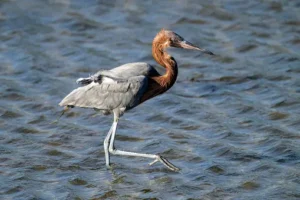
- The reddish egret is known for its unique and flamboyant appearance. It has a shaggy, ruffled appearance with long, shaggy neck feathers and a tuft of feathers on its head. During its breeding season, it has a reddish or rust-colored body and head, which gives it its name. Outside of the breeding season, its plumage can be more grayish-blue.
- The reddish egret is known for its unique and dynamic hunting techniques. It uses various strategies to catch fish, including running and spinning in circles, spreading its wings to create shade and reduce glare on the water, and using its wings to create a “canopy” to attract fish. These behaviors make the reddish egret a captivating bird to observe in its natural habitat.
- While not as globally endangered as some other egret species, the reddish egret has faced habitat loss and other threats in certain areas. Conservation efforts often focus on protecting and preserving its coastal and wetland habitats, as well as raising awareness about the importance of these ecosystems for the reddish egret and other wildlife.
- Reddish egrets typically nest in colonies along with other wading birds. Their nests are often built in trees or shrubs near water. They lay eggs and raise their young in these nesting sites.
15. Ring-billed Gull Of Florida Beach Birds
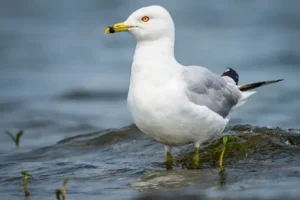
- The ring-billed gull has a white body with gray wings and back. Its most noticeable feature is the black ring around its bill, which becomes more prominent during the breeding season. Juveniles typically have mottled brown and white plumage and lack the black ring on the bill.
- Ring-billed gulls are highly adaptable and can be found in a range of habitats, including coastal areas, lakeshores, rivers, reservoirs, and even parking lots and urban settings. They are often seen scavenging for food around garbage dumps, beaches, and picnic areas.
- These gulls have an omnivorous diet, feeding on a variety of items including fish, insects, crustaceans, small mammals, plant matter, and human food scraps. Their opportunistic feeding habits have contributed to their success in urban environments.
- Ring-billed gulls typically breed in colonies near water, on islands, or along the shoreline. They build nests on the ground using sticks, grass, and other materials. The female usually lays 2-4 eggs, and both parents take turns incubating them. After hatching, the chicks are precocial, meaning they are relatively mature and able to feed themselves shortly after hatching.
- Many ring-billed gulls are migratory, with some populations migrating south for the winter. They can be found throughout much of North America during the breeding season and may travel to southern coastal areas or further south for the colder months.
- Ring-billed gulls are known for their vocalizations, which include a variety of calls and squawks. They are also skilled fliers and can be seen soaring, gliding, and hovering on the wind currents.
16. Ruddy Turnstone
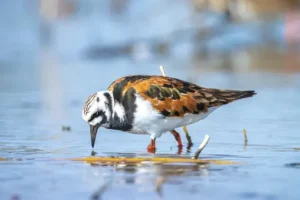
- Ruddy turnstones have a striking appearance with a rich combination of colors. During the breeding season, they have a ruddy or reddish-brown plumage on their back, wings, and head, contrasting with a black face and white underparts. In winter, their plumage becomes more grayish-brown. They have a short, slightly upturned bill that is adapted for probing and flipping objects.
- Ruddy turnstones can be found in a variety of coastal habitats, including sandy beaches, rocky shores, mudflats, and coastal marshes. They are often seen foraging along the shorelines and in intertidal zones.
- Ruddy turnstones are known for their unique feeding behavior. They use their stout bills to flip over rocks, shells, and other objects to uncover insects, crustaceans, and other small prey hiding underneath. This behavior has earned them their name “turnstone. They also feed on small mollusks, marine worms, and other invertebrates.
- Ruddy turnstones are migratory birds, breeding in the Arctic tundra regions of North America, Europe, and Asia during the summer months. They undertake long migrations to their non-breeding grounds in temperate and tropical regions, including coastal areas of North and South America, Africa, and Asia.
- During the breeding season, ruddy turnstones nest in rocky or gravelly tundra areas near water. They build simple nests lined with vegetation and lay a clutch of eggs.
- While the ruddy turnstone is not currently considered globally threatened, certain populations may face habitat loss and disturbance from human activities. Conservation efforts may focus on protecting important breeding and wintering areas, as well as raising awareness about the importance of coastal habitats for migratory shorebirds.
See For More Info: Top 12 Highest Flying Birds In The World
17. Sanderling
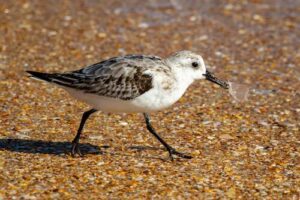
- Sanderlings have a compact and plump body with short legs. In breeding plumage, they have a reddish-brown back and a white underside. During the non-breeding season, their plumage becomes mostly pale gray or white. They have a distinctive black beak that is slightly curved, and their legs are black in color.
- Sanderlings are found in a wide range of coastal habitats, including sandy beaches, mudflats, rocky shores, and coastal lagoons. They are often seen running along the water’s edge as they forage for food.
- Sanderlings have a unique feeding behavior similar to the ruddy turnstone. They use their bills to probe and peck at the sand and mud, searching for small invertebrates such as crustaceans, mollusks, and marine worms. They are known for their quick and incessant movement, constantly running back and forth along the shoreline as they feed.
- Sanderlings are highly migratory birds. They breed in the Arctic tundra regions of North America, Europe, and Asia during the summer months. In the winter, they travel long distances to their non-breeding grounds, which include coastal areas in North and South America, Europe, Africa, and Asia.
- Sanderlings are known for their high-energy foraging behavior. They are often seen in small to large flocks, running in unison along the shoreline as waves come and go. They have a distinct “wave chase” behavior, where they retreat from incoming waves and then quickly move forward to forage as the water recedes.
- Sanderlings are not currently considered globally threatened, but local populations may face challenges due to habitat degradation, disturbance from human activities, and other environmental factors. Conservation efforts often focus on protecting key breeding and wintering areas and promoting responsible coastal management practices.
18. Sandwich Tern
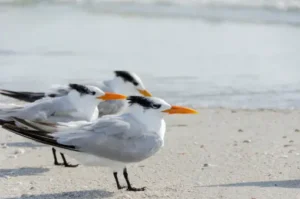
- The sandwich tern is a medium-sized tern with a distinctive appearance. They have a white body, a black cap on the head during the breeding season (which becomes more mottled outside of the breeding season), a long, slightly forked tail, and a sharp, pointed beak. Young terns have a mottled appearance and no black cap.
- The woodcock is a shorebird that lives in a wide variety of marine and coastal habitats. They can be found on sandy beaches, tidal flats, estuaries and rocky coasts and offshore islands, where they often breed in colonies.
- These terns are excellent divers and dive into aerial waters to fish. They feed primarily on small fish, which they find by hovering above the water and then diving headfirst to catch their prey.
- Woodcock breed in colonies and often nest with other seabird species. They build their nests in shallow depressions in sand, gravel or vegetation, and males and females take turns incubating the eggs. Chicks are precocious, which means they are born relatively well developed and able to move soon after hatching.
- Snipes are migratory birds found in various parts of Europe, Africa and America. They breed in the northern hemisphere and migrate south to wintering areas in the tropics and subtropics.
- The sand bird’s conservation status varies from region to region, but in some areas it can be vulnerable to threats such as habitat loss, disturbance of breeding sites, and destruction from pollution. Conservation efforts often focus on protecting important nesting and feeding areas, as well as raising awareness of the importance of protecting coastal habitats.
19. Snowy Egret
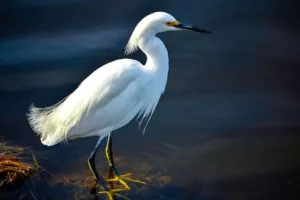
- Snow egrets are medium-sized herons with all-white plumage. They have slender bodies, long necks, and long black legs with prominent yellow feet. Long, thin feathers develop on the back, head and neck during the breeding season, enhancing their ornamental appearance.
- The snowy egret inhabits a variety of wetlands including coastal areas, estuaries, swamps, lagoons and freshwater ponds.
- One of the great egret’s most distinctive characteristics is the way it feeds. They are skilled foragers, using their bright yellow feet to mix mud and water to destroy prey such as small fish, crustaceans, and insects. Then they use their sharp beak to catch their prey.
- The Great Egret often nests in colonies with other shorebirds. They build nests in trees or bushes near water using sticks, twigs, and other materials. Males and females take turns incubating the eggs and caring for the chicks.
- Although the snow egret is not currently listed as a globally threatened species, its species has experienced an historic decline due to excessive deforestation for timber prized in the wildlife trade in the late 19th and early 20th centuries. Conservation efforts, including the introduction of conservation laws, have helped populations recover. Today, the snow egret benefits from efforts to protect its habitat and wetlands.
- Snow Egrets are known for their graceful and agile movements. They often walk slowly through shallow water, using their foraging technique to stalk and capture their prey. When frightened, they can fly into the air with a characteristic slow, deep flap of their wings.
20. Spotted Sandpiper
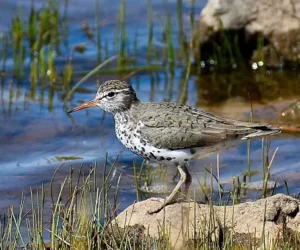
- Spotted sandpipers have a plump body, a short neck, and relatively long legs. They have a mottled brown or grayish-brown back with distinctive large black spots on their white underparts. Their breast often appears streaked or speckled. They have a white eyebrow stripe and a distinctive teetering tail bobbing motion.
- Spotted sandpipers can be found in a variety of freshwater and saltwater habitats. They are commonly seen along the edges of lakes, rivers, streams, ponds, and estuaries. During migration, they may also be found on coastal beaches.
- The spotted sandpiper is known for its unique teetering or bobbing motion. When it is on the ground, it bobs its rear end up and down, giving it its characteristic appearance. This behavior is thought to be a territorial and courtship display. Spotted sandpipers are also solitary and often seen foraging along the water’s edge.
- Spotted sandpipers are known for their role reversal in breeding. In many bird species, males are more colorful and have more elaborate plumage, but in spotted sandpipers, the females are larger and more brightly colored. Additionally, female spotted sandpipers are often the ones that establish territories and court males.
- Spotted sandpipers are migratory birds. They breed across North America and then migrate to Central and South America for the winter. Their migration patterns are complex, with different populations taking different routes and wintering in various locations.
- Spotted sandpipers primarily feed on small aquatic insects, crustaceans, mollusks, and other invertebrates. They use their bills to probe and pick at the water’s edge and shallow water to find food.
- The spotted sandpiper is not considered globally threatened. However, like many other shorebirds, it may face challenges such as habitat loss, disturbance at breeding sites, and other environmental factors. Wetland conservation efforts and protection of critical stopover sites are important for maintaining healthy populations of spotted sandpipers and other migratory birds.
FAQ’s:
What types of beach birds can I expect to see in Florida?
Florida is home to a diverse range of beach birds, including pelicans, seagulls, sandpipers, herons, and plovers. This article showcases 20 different species with pictures to help you identify them.
Are these birds exclusive to Florida’s beaches or can they be found elsewhere?
While some of the bird species featured in the article may also be found in other coastal areas, Florida’s unique ecosystem offers a habitat for a variety of beach birds that can be observed and photographed along its beaches.
How can I identify these Florida beach birds based on their appearance?
Each bird’s distinctive characteristics, such as size, color, markings, and behavior, are highlighted with accompanying pictures to help you identify and differentiate them from one another.
When is the best time to spot these birds on Florida’s beaches?
Many of these beach birds are present year-round, while others may migrate to or through Florida during specific seasons. The article provides insights into the typical timing for observing these species.
Are these birds affected by coastal conservation efforts in Florida?
Yes, several of these beach bird species may benefit from conservation initiatives aimed at protecting Florida’s coastal habitats, including nesting sites and feeding grounds. The article might touch on the importance of conservation efforts for the well-being of these birds.
